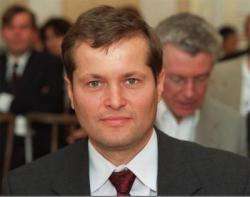Prestigious award for the generation of attosecond pulses

Professor Ferenc Krausz, Director at Max Planck Institute of Quantum Optics, receives the 2006 IEEE/LEOS Quantum Electronics Award
This award recognizes truly excellent and time-tested work in any of the fields of interest of LEOS. The 2006 IEEE Quantum Electronics Award will be presented to Ferenc Krausz for outstanding contributions to the field of ultrafast science, in particular to the generation of single attosecond pulses."
Professor Ferenc Krausz is recognized as one of the world’s leading scientists in the field of attosecond physics. In 2002 (when he was still professor at the University of Technology, Vienna) he succeeded - in collaborative work with Prof. Theodor Hänsch (Director at Max Planck Institute of Quantum Optics) using the Nobel Prize winning Frequency Comb-Technique - in developing "phase-stabilized" lasers for generating femtosecond pulses (a femtosecond is a millionth of a billionth of a second). This type of laser generates pulses that are identical from pulse to pulse not only in intensity and frequency but also in the position of the maxima and minima of the light oscillations. The perfectly controlled high-intensity fields of theses femtosecond pulses exert forces on electrically charged elementary particles (electrons or protons) that are comparable to intra-atomic forces.
This is the precondition for advancing into the attosecond domain (an attosecond is a billionth of a billionth of a second). When perfectly controlled femtosecond pulses hit gas atoms in a so-called "target", their strong electric field first knocks an electron from the atom and then immediately hurls it back. The recaptured electron emits the absorbed energy as a short light flash in the XUV (extremely short-wave ultraviolet) region.
The flash emitted by a single atom is immeasurable weak. However, millions of atoms are targeted by the femtosecond pulses and subsequently emit attosecond flashes perfectly synchronized with millisecond timing. This generates a strongly collimated laser-type beam of light pulses with a duration of 250 attoseconds. The SCIENCE journal celebrated the first production of attosecond radiation as one of the 10 most important achievements in science in 2002.
In 2003 Professor Krausz was appointed Director at Max Planck Institute of Quantum Optics (MPQ), where he is head of the "Attosecond and High-Field Physics" division. In 2004 he was also made head of the Department of Experimental Physics at Ludwig Maximilian’s University of Munich (LMU). The main interest of his MPQ-LMU-team is the control and real-time observation of the motion of electrons in atoms, molecules and solids using attosecond measuring technique.
Professor Krausz and his team are also pursuing the goal of developing new tools (e.g. high-energy electron and X-ray beams) for investigating microscopic processes with high resolution in both space and time. Such tools would constitute a space-time microscope that makes the motion of electrons visible with subatomic resolution in slow motion. The new radiation sources could also afford new prospects in structural biology and in the diagnosis and therapy of cancer.
Source: Max-Planck-Gesellschaft





















